Child, Adolescent, and Family Nursing: Rheumatic Fever in Adolescents
VerifiedAdded on 2023/06/08
|8
|2530
|235
Essay
AI Summary
This essay delves into the critical aspects of child, adolescent, and family nursing, emphasizing health promotion for newborns, children, and teenagers within a family context. It examines a case study of a 14-year-old girl in rural Australia diagnosed with acute rheumatic fever, highlighting the pathophysiology of rheumatic heart disease (RHD) and the importance of timely hospitalization and family-centered care. The essay explores relevant developmental theories, such as Freud's psychosexual theory, to understand the adolescent's needs and the nurse's role in providing education and support to the family. It also discusses the benefits of family-centered care in improving patient outcomes and the significance of considering the family's cultural background and financial situation. The essay concludes by emphasizing the need for pediatric nursing care to adopt a family-centered approach to maximize the well-being of pediatric patients and their families.
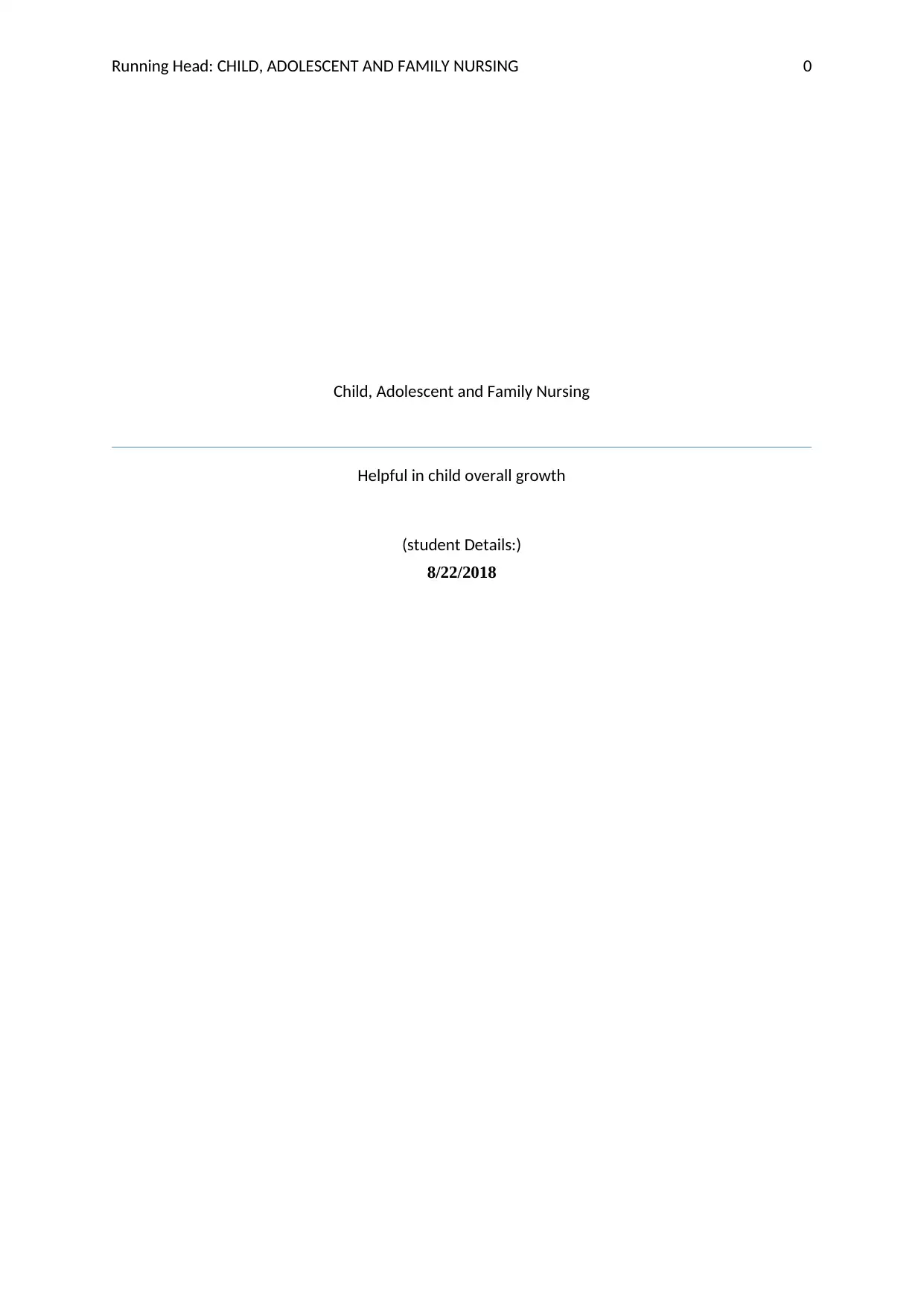
Running Head: CHILD, ADOLESCENT AND FAMILY NURSING 0
Child, Adolescent and Family Nursing
Helpful in child overall growth
(student Details:)
8/22/2018
Child, Adolescent and Family Nursing
Helpful in child overall growth
(student Details:)
8/22/2018
Paraphrase This Document
Need a fresh take? Get an instant paraphrase of this document with our AI Paraphraser
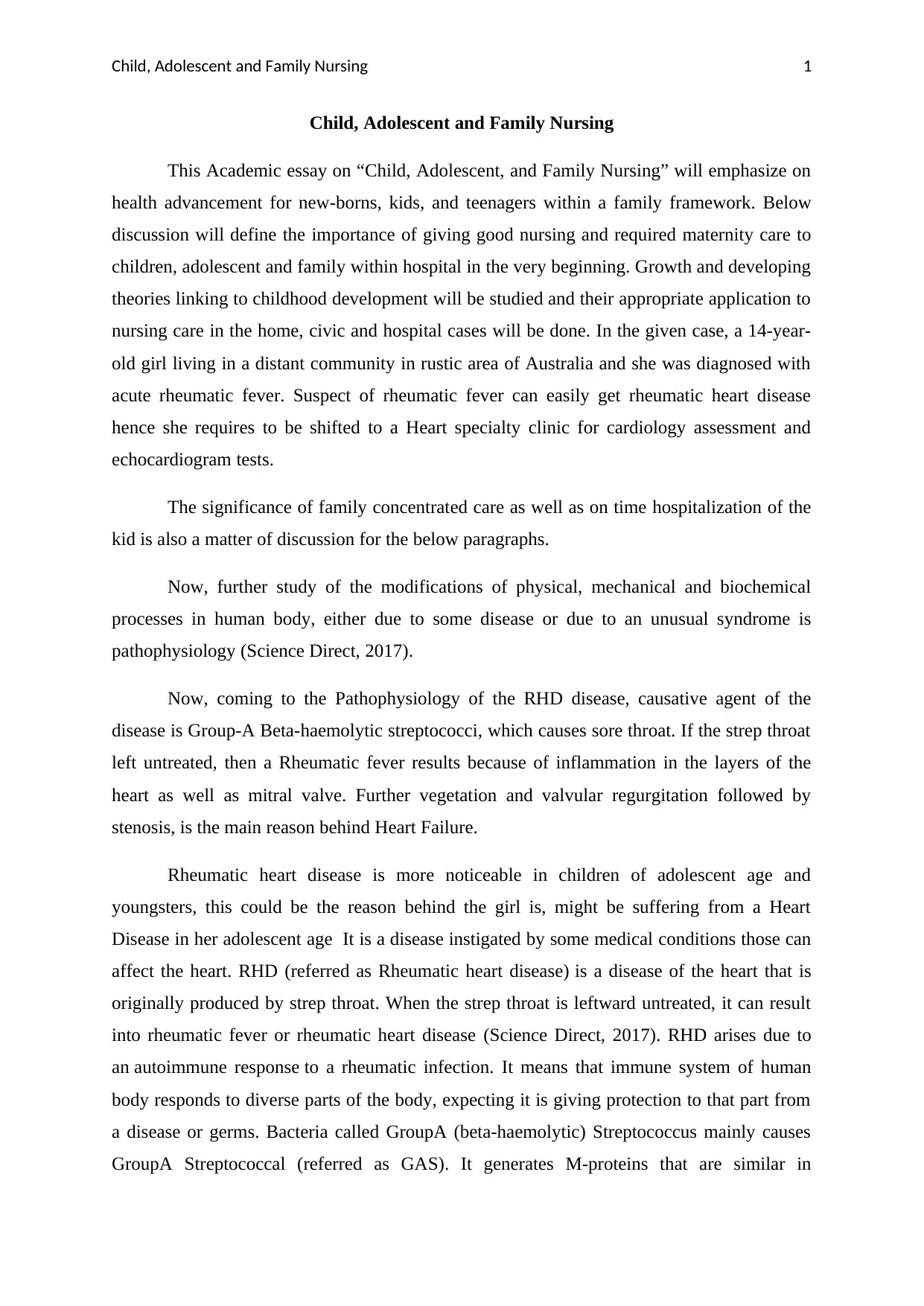
Child, Adolescent and Family Nursing 1
Child, Adolescent and Family Nursing
This Academic essay on “Child, Adolescent, and Family Nursing” will emphasize on
health advancement for new-borns, kids, and teenagers within a family framework. Below
discussion will define the importance of giving good nursing and required maternity care to
children, adolescent and family within hospital in the very beginning. Growth and developing
theories linking to childhood development will be studied and their appropriate application to
nursing care in the home, civic and hospital cases will be done. In the given case, a 14-year-
old girl living in a distant community in rustic area of Australia and she was diagnosed with
acute rheumatic fever. Suspect of rheumatic fever can easily get rheumatic heart disease
hence she requires to be shifted to a Heart specialty clinic for cardiology assessment and
echocardiogram tests.
The significance of family concentrated care as well as on time hospitalization of the
kid is also a matter of discussion for the below paragraphs.
Now, further study of the modifications of physical, mechanical and biochemical
processes in human body, either due to some disease or due to an unusual syndrome is
pathophysiology (Science Direct, 2017).
Now, coming to the Pathophysiology of the RHD disease, causative agent of the
disease is Group-A Beta-haemolytic streptococci, which causes sore throat. If the strep throat
left untreated, then a Rheumatic fever results because of inflammation in the layers of the
heart as well as mitral valve. Further vegetation and valvular regurgitation followed by
stenosis, is the main reason behind Heart Failure.
Rheumatic heart disease is more noticeable in children of adolescent age and
youngsters, this could be the reason behind the girl is, might be suffering from a Heart
Disease in her adolescent age It is a disease instigated by some medical conditions those can
affect the heart. RHD (referred as Rheumatic heart disease) is a disease of the heart that is
originally produced by strep throat. When the strep throat is leftward untreated, it can result
into rheumatic fever or rheumatic heart disease (Science Direct, 2017). RHD arises due to
an autoimmune response to a rheumatic infection. It means that immune system of human
body responds to diverse parts of the body, expecting it is giving protection to that part from
a disease or germs. Bacteria called GroupA (beta-haemolytic) Streptococcus mainly causes
GroupA Streptococcal (referred as GAS). It generates M-proteins that are similar in
Child, Adolescent and Family Nursing
This Academic essay on “Child, Adolescent, and Family Nursing” will emphasize on
health advancement for new-borns, kids, and teenagers within a family framework. Below
discussion will define the importance of giving good nursing and required maternity care to
children, adolescent and family within hospital in the very beginning. Growth and developing
theories linking to childhood development will be studied and their appropriate application to
nursing care in the home, civic and hospital cases will be done. In the given case, a 14-year-
old girl living in a distant community in rustic area of Australia and she was diagnosed with
acute rheumatic fever. Suspect of rheumatic fever can easily get rheumatic heart disease
hence she requires to be shifted to a Heart specialty clinic for cardiology assessment and
echocardiogram tests.
The significance of family concentrated care as well as on time hospitalization of the
kid is also a matter of discussion for the below paragraphs.
Now, further study of the modifications of physical, mechanical and biochemical
processes in human body, either due to some disease or due to an unusual syndrome is
pathophysiology (Science Direct, 2017).
Now, coming to the Pathophysiology of the RHD disease, causative agent of the
disease is Group-A Beta-haemolytic streptococci, which causes sore throat. If the strep throat
left untreated, then a Rheumatic fever results because of inflammation in the layers of the
heart as well as mitral valve. Further vegetation and valvular regurgitation followed by
stenosis, is the main reason behind Heart Failure.
Rheumatic heart disease is more noticeable in children of adolescent age and
youngsters, this could be the reason behind the girl is, might be suffering from a Heart
Disease in her adolescent age It is a disease instigated by some medical conditions those can
affect the heart. RHD (referred as Rheumatic heart disease) is a disease of the heart that is
originally produced by strep throat. When the strep throat is leftward untreated, it can result
into rheumatic fever or rheumatic heart disease (Science Direct, 2017). RHD arises due to
an autoimmune response to a rheumatic infection. It means that immune system of human
body responds to diverse parts of the body, expecting it is giving protection to that part from
a disease or germs. Bacteria called GroupA (beta-haemolytic) Streptococcus mainly causes
GroupA Streptococcal (referred as GAS). It generates M-proteins that are similar in
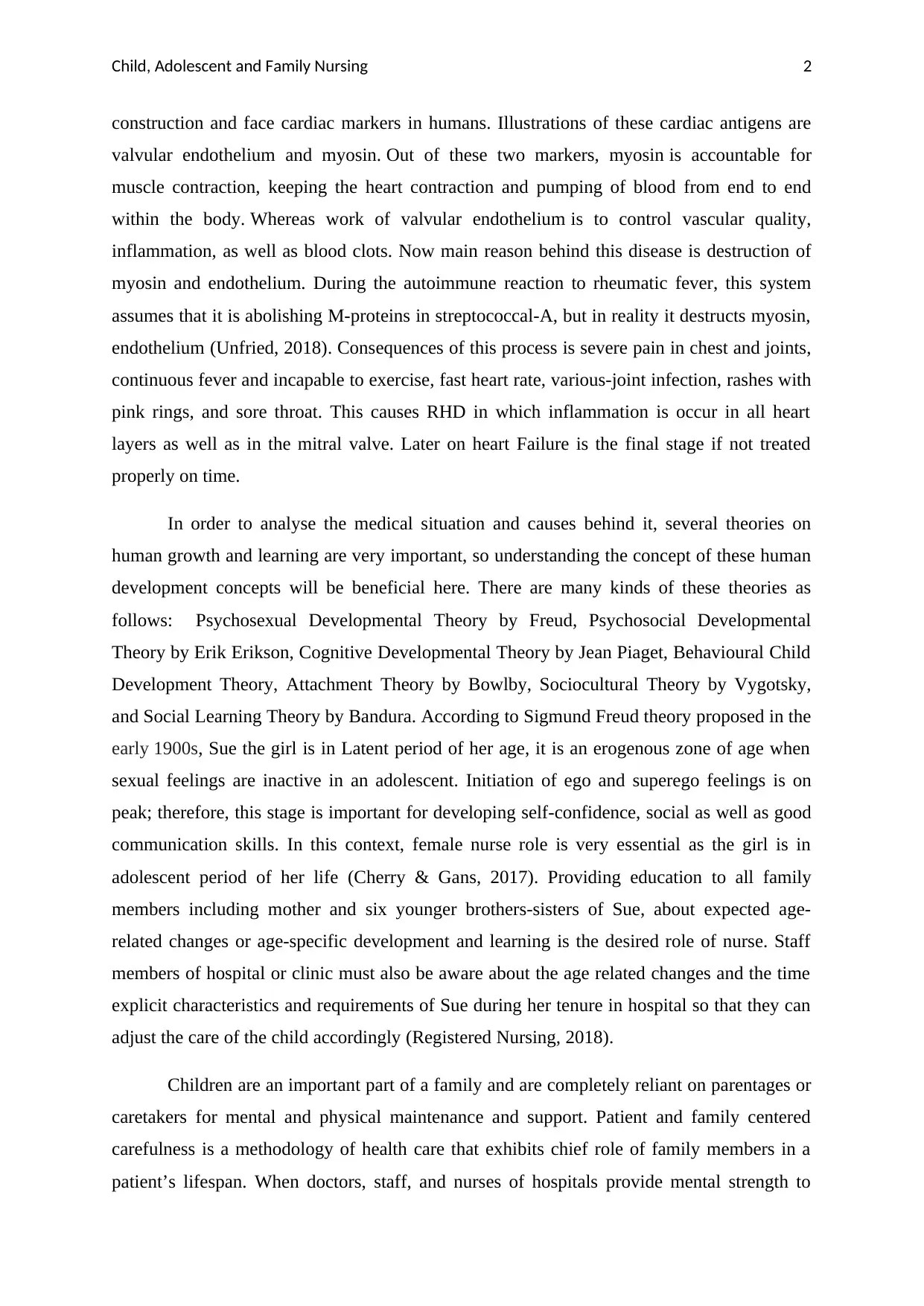
Child, Adolescent and Family Nursing 2
construction and face cardiac markers in humans. Illustrations of these cardiac antigens are
valvular endothelium and myosin. Out of these two markers, myosin is accountable for
muscle contraction, keeping the heart contraction and pumping of blood from end to end
within the body. Whereas work of valvular endothelium is to control vascular quality,
inflammation, as well as blood clots. Now main reason behind this disease is destruction of
myosin and endothelium. During the autoimmune reaction to rheumatic fever, this system
assumes that it is abolishing M-proteins in streptococcal-A, but in reality it destructs myosin,
endothelium (Unfried, 2018). Consequences of this process is severe pain in chest and joints,
continuous fever and incapable to exercise, fast heart rate, various-joint infection, rashes with
pink rings, and sore throat. This causes RHD in which inflammation is occur in all heart
layers as well as in the mitral valve. Later on heart Failure is the final stage if not treated
properly on time.
In order to analyse the medical situation and causes behind it, several theories on
human growth and learning are very important, so understanding the concept of these human
development concepts will be beneficial here. There are many kinds of these theories as
follows: Psychosexual Developmental Theory by Freud, Psychosocial Developmental
Theory by Erik Erikson, Cognitive Developmental Theory by Jean Piaget, Behavioural Child
Development Theory, Attachment Theory by Bowlby, Sociocultural Theory by Vygotsky,
and Social Learning Theory by Bandura. According to Sigmund Freud theory proposed in the
early 1900s, Sue the girl is in Latent period of her age, it is an erogenous zone of age when
sexual feelings are inactive in an adolescent. Initiation of ego and superego feelings is on
peak; therefore, this stage is important for developing self-confidence, social as well as good
communication skills. In this context, female nurse role is very essential as the girl is in
adolescent period of her life (Cherry & Gans, 2017). Providing education to all family
members including mother and six younger brothers-sisters of Sue, about expected age-
related changes or age-specific development and learning is the desired role of nurse. Staff
members of hospital or clinic must also be aware about the age related changes and the time
explicit characteristics and requirements of Sue during her tenure in hospital so that they can
adjust the care of the child accordingly (Registered Nursing, 2018).
Children are an important part of a family and are completely reliant on parentages or
caretakers for mental and physical maintenance and support. Patient and family centered
carefulness is a methodology of health care that exhibits chief role of family members in a
patient’s lifespan. When doctors, staff, and nurses of hospitals provide mental strength to
construction and face cardiac markers in humans. Illustrations of these cardiac antigens are
valvular endothelium and myosin. Out of these two markers, myosin is accountable for
muscle contraction, keeping the heart contraction and pumping of blood from end to end
within the body. Whereas work of valvular endothelium is to control vascular quality,
inflammation, as well as blood clots. Now main reason behind this disease is destruction of
myosin and endothelium. During the autoimmune reaction to rheumatic fever, this system
assumes that it is abolishing M-proteins in streptococcal-A, but in reality it destructs myosin,
endothelium (Unfried, 2018). Consequences of this process is severe pain in chest and joints,
continuous fever and incapable to exercise, fast heart rate, various-joint infection, rashes with
pink rings, and sore throat. This causes RHD in which inflammation is occur in all heart
layers as well as in the mitral valve. Later on heart Failure is the final stage if not treated
properly on time.
In order to analyse the medical situation and causes behind it, several theories on
human growth and learning are very important, so understanding the concept of these human
development concepts will be beneficial here. There are many kinds of these theories as
follows: Psychosexual Developmental Theory by Freud, Psychosocial Developmental
Theory by Erik Erikson, Cognitive Developmental Theory by Jean Piaget, Behavioural Child
Development Theory, Attachment Theory by Bowlby, Sociocultural Theory by Vygotsky,
and Social Learning Theory by Bandura. According to Sigmund Freud theory proposed in the
early 1900s, Sue the girl is in Latent period of her age, it is an erogenous zone of age when
sexual feelings are inactive in an adolescent. Initiation of ego and superego feelings is on
peak; therefore, this stage is important for developing self-confidence, social as well as good
communication skills. In this context, female nurse role is very essential as the girl is in
adolescent period of her life (Cherry & Gans, 2017). Providing education to all family
members including mother and six younger brothers-sisters of Sue, about expected age-
related changes or age-specific development and learning is the desired role of nurse. Staff
members of hospital or clinic must also be aware about the age related changes and the time
explicit characteristics and requirements of Sue during her tenure in hospital so that they can
adjust the care of the child accordingly (Registered Nursing, 2018).
Children are an important part of a family and are completely reliant on parentages or
caretakers for mental and physical maintenance and support. Patient and family centered
carefulness is a methodology of health care that exhibits chief role of family members in a
patient’s lifespan. When doctors, staff, and nurses of hospitals provide mental strength to
⊘ This is a preview!⊘
Do you want full access?
Subscribe today to unlock all pages.

Trusted by 1+ million students worldwide
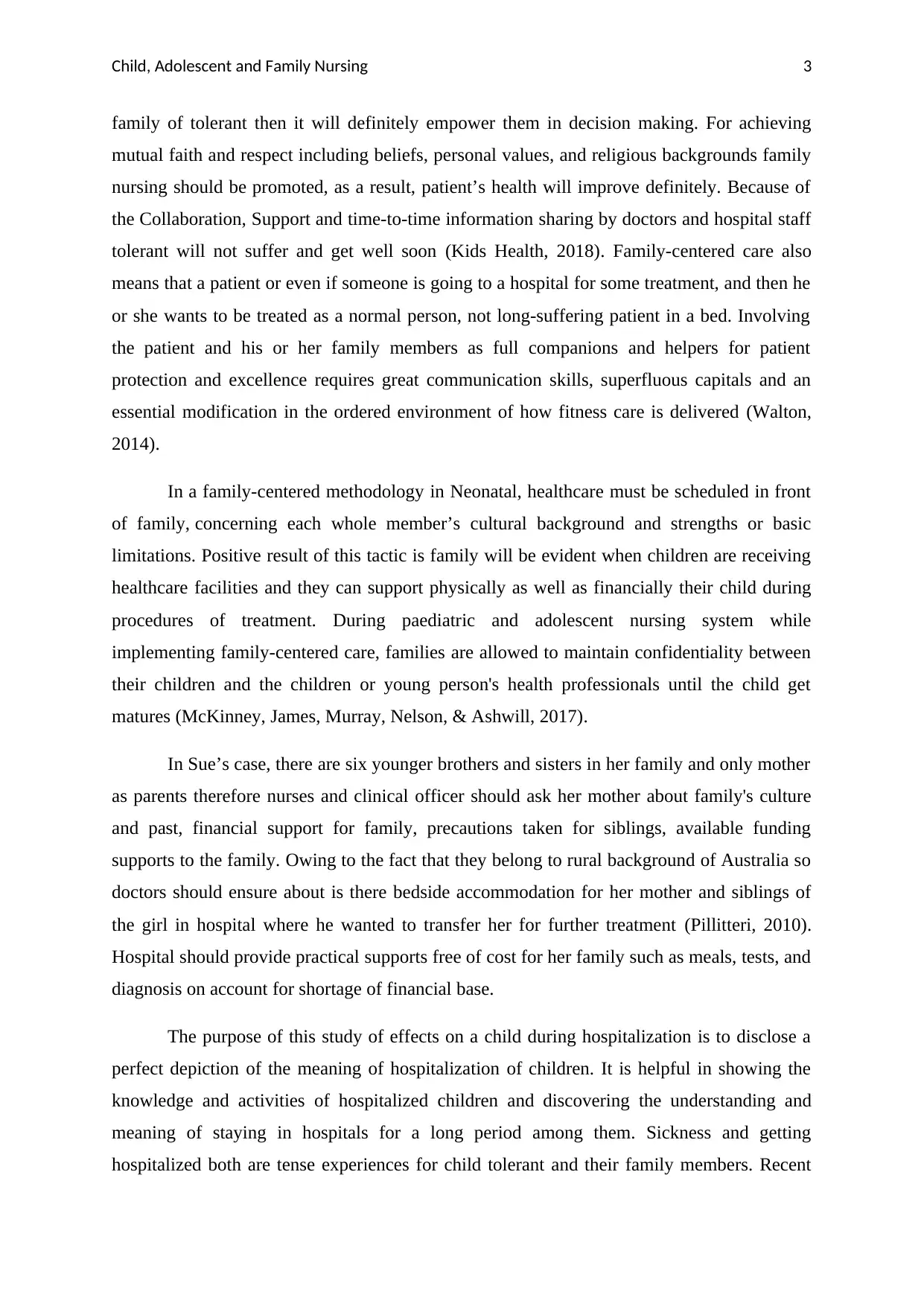
Child, Adolescent and Family Nursing 3
family of tolerant then it will definitely empower them in decision making. For achieving
mutual faith and respect including beliefs, personal values, and religious backgrounds family
nursing should be promoted, as a result, patient’s health will improve definitely. Because of
the Collaboration, Support and time-to-time information sharing by doctors and hospital staff
tolerant will not suffer and get well soon (Kids Health, 2018). Family-centered care also
means that a patient or even if someone is going to a hospital for some treatment, and then he
or she wants to be treated as a normal person, not long-suffering patient in a bed. Involving
the patient and his or her family members as full companions and helpers for patient
protection and excellence requires great communication skills, superfluous capitals and an
essential modification in the ordered environment of how fitness care is delivered (Walton,
2014).
In a family-centered methodology in Neonatal, healthcare must be scheduled in front
of family, concerning each whole member’s cultural background and strengths or basic
limitations. Positive result of this tactic is family will be evident when children are receiving
healthcare facilities and they can support physically as well as financially their child during
procedures of treatment. During paediatric and adolescent nursing system while
implementing family-centered care, families are allowed to maintain confidentiality between
their children and the children or young person's health professionals until the child get
matures (McKinney, James, Murray, Nelson, & Ashwill, 2017).
In Sue’s case, there are six younger brothers and sisters in her family and only mother
as parents therefore nurses and clinical officer should ask her mother about family's culture
and past, financial support for family, precautions taken for siblings, available funding
supports to the family. Owing to the fact that they belong to rural background of Australia so
doctors should ensure about is there bedside accommodation for her mother and siblings of
the girl in hospital where he wanted to transfer her for further treatment (Pillitteri, 2010).
Hospital should provide practical supports free of cost for her family such as meals, tests, and
diagnosis on account for shortage of financial base.
The purpose of this study of effects on a child during hospitalization is to disclose a
perfect depiction of the meaning of hospitalization of children. It is helpful in showing the
knowledge and activities of hospitalized children and discovering the understanding and
meaning of staying in hospitals for a long period among them. Sickness and getting
hospitalized both are tense experiences for child tolerant and their family members. Recent
family of tolerant then it will definitely empower them in decision making. For achieving
mutual faith and respect including beliefs, personal values, and religious backgrounds family
nursing should be promoted, as a result, patient’s health will improve definitely. Because of
the Collaboration, Support and time-to-time information sharing by doctors and hospital staff
tolerant will not suffer and get well soon (Kids Health, 2018). Family-centered care also
means that a patient or even if someone is going to a hospital for some treatment, and then he
or she wants to be treated as a normal person, not long-suffering patient in a bed. Involving
the patient and his or her family members as full companions and helpers for patient
protection and excellence requires great communication skills, superfluous capitals and an
essential modification in the ordered environment of how fitness care is delivered (Walton,
2014).
In a family-centered methodology in Neonatal, healthcare must be scheduled in front
of family, concerning each whole member’s cultural background and strengths or basic
limitations. Positive result of this tactic is family will be evident when children are receiving
healthcare facilities and they can support physically as well as financially their child during
procedures of treatment. During paediatric and adolescent nursing system while
implementing family-centered care, families are allowed to maintain confidentiality between
their children and the children or young person's health professionals until the child get
matures (McKinney, James, Murray, Nelson, & Ashwill, 2017).
In Sue’s case, there are six younger brothers and sisters in her family and only mother
as parents therefore nurses and clinical officer should ask her mother about family's culture
and past, financial support for family, precautions taken for siblings, available funding
supports to the family. Owing to the fact that they belong to rural background of Australia so
doctors should ensure about is there bedside accommodation for her mother and siblings of
the girl in hospital where he wanted to transfer her for further treatment (Pillitteri, 2010).
Hospital should provide practical supports free of cost for her family such as meals, tests, and
diagnosis on account for shortage of financial base.
The purpose of this study of effects on a child during hospitalization is to disclose a
perfect depiction of the meaning of hospitalization of children. It is helpful in showing the
knowledge and activities of hospitalized children and discovering the understanding and
meaning of staying in hospitals for a long period among them. Sickness and getting
hospitalized both are tense experiences for child tolerant and their family members. Recent
Paraphrase This Document
Need a fresh take? Get an instant paraphrase of this document with our AI Paraphraser
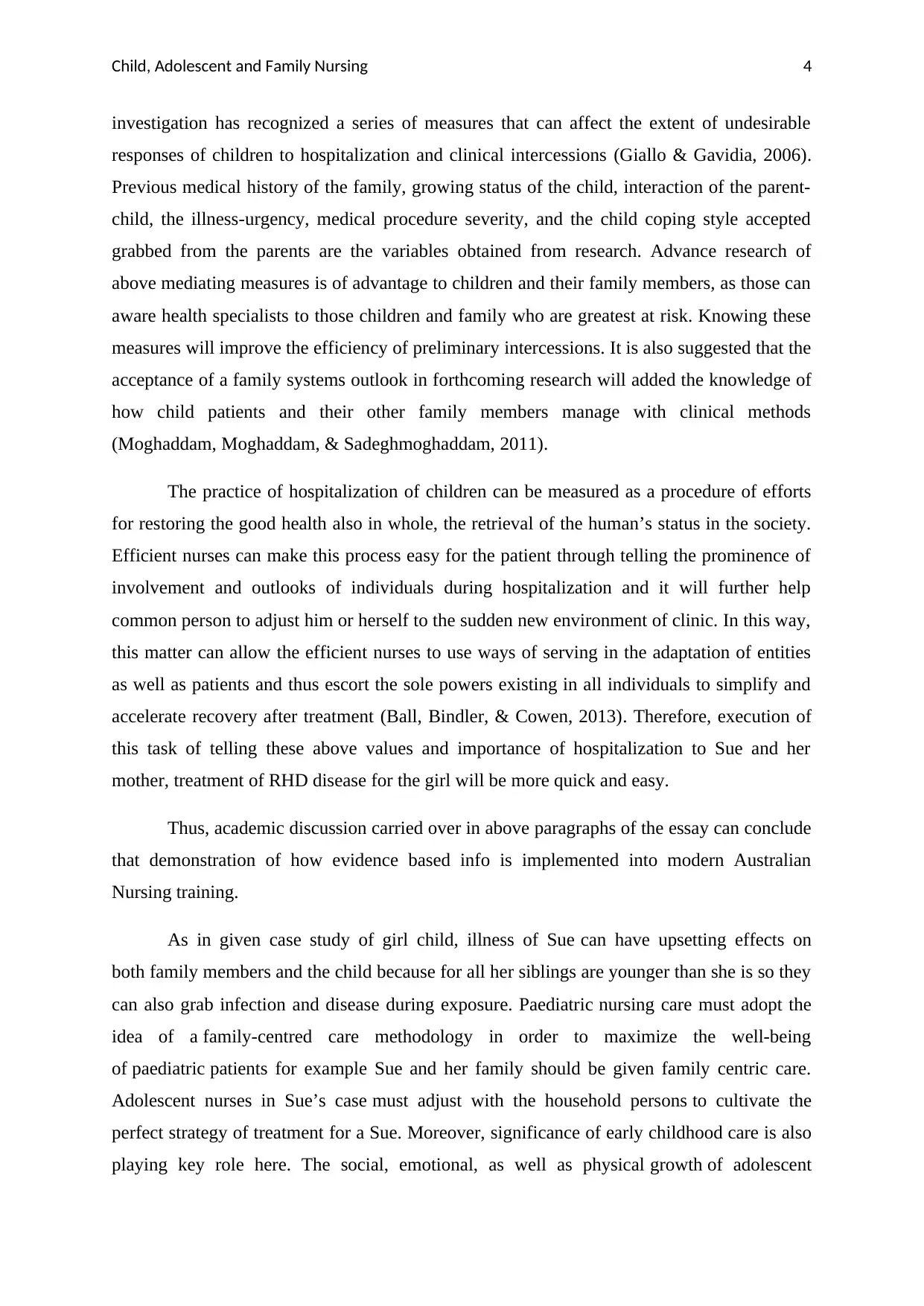
Child, Adolescent and Family Nursing 4
investigation has recognized a series of measures that can affect the extent of undesirable
responses of children to hospitalization and clinical intercessions (Giallo & Gavidia, 2006).
Previous medical history of the family, growing status of the child, interaction of the parent-
child, the illness-urgency, medical procedure severity, and the child coping style accepted
grabbed from the parents are the variables obtained from research. Advance research of
above mediating measures is of advantage to children and their family members, as those can
aware health specialists to those children and family who are greatest at risk. Knowing these
measures will improve the efficiency of preliminary intercessions. It is also suggested that the
acceptance of a family systems outlook in forthcoming research will added the knowledge of
how child patients and their other family members manage with clinical methods
(Moghaddam, Moghaddam, & Sadeghmoghaddam, 2011).
The practice of hospitalization of children can be measured as a procedure of efforts
for restoring the good health also in whole, the retrieval of the human’s status in the society.
Efficient nurses can make this process easy for the patient through telling the prominence of
involvement and outlooks of individuals during hospitalization and it will further help
common person to adjust him or herself to the sudden new environment of clinic. In this way,
this matter can allow the efficient nurses to use ways of serving in the adaptation of entities
as well as patients and thus escort the sole powers existing in all individuals to simplify and
accelerate recovery after treatment (Ball, Bindler, & Cowen, 2013). Therefore, execution of
this task of telling these above values and importance of hospitalization to Sue and her
mother, treatment of RHD disease for the girl will be more quick and easy.
Thus, academic discussion carried over in above paragraphs of the essay can conclude
that demonstration of how evidence based info is implemented into modern Australian
Nursing training.
As in given case study of girl child, illness of Sue can have upsetting effects on
both family members and the child because for all her siblings are younger than she is so they
can also grab infection and disease during exposure. Paediatric nursing care must adopt the
idea of a family-centred care methodology in order to maximize the well-being
of paediatric patients for example Sue and her family should be given family centric care.
Adolescent nurses in Sue’s case must adjust with the household persons to cultivate the
perfect strategy of treatment for a Sue. Moreover, significance of early childhood care is also
playing key role here. The social, emotional, as well as physical growth of adolescent
investigation has recognized a series of measures that can affect the extent of undesirable
responses of children to hospitalization and clinical intercessions (Giallo & Gavidia, 2006).
Previous medical history of the family, growing status of the child, interaction of the parent-
child, the illness-urgency, medical procedure severity, and the child coping style accepted
grabbed from the parents are the variables obtained from research. Advance research of
above mediating measures is of advantage to children and their family members, as those can
aware health specialists to those children and family who are greatest at risk. Knowing these
measures will improve the efficiency of preliminary intercessions. It is also suggested that the
acceptance of a family systems outlook in forthcoming research will added the knowledge of
how child patients and their other family members manage with clinical methods
(Moghaddam, Moghaddam, & Sadeghmoghaddam, 2011).
The practice of hospitalization of children can be measured as a procedure of efforts
for restoring the good health also in whole, the retrieval of the human’s status in the society.
Efficient nurses can make this process easy for the patient through telling the prominence of
involvement and outlooks of individuals during hospitalization and it will further help
common person to adjust him or herself to the sudden new environment of clinic. In this way,
this matter can allow the efficient nurses to use ways of serving in the adaptation of entities
as well as patients and thus escort the sole powers existing in all individuals to simplify and
accelerate recovery after treatment (Ball, Bindler, & Cowen, 2013). Therefore, execution of
this task of telling these above values and importance of hospitalization to Sue and her
mother, treatment of RHD disease for the girl will be more quick and easy.
Thus, academic discussion carried over in above paragraphs of the essay can conclude
that demonstration of how evidence based info is implemented into modern Australian
Nursing training.
As in given case study of girl child, illness of Sue can have upsetting effects on
both family members and the child because for all her siblings are younger than she is so they
can also grab infection and disease during exposure. Paediatric nursing care must adopt the
idea of a family-centred care methodology in order to maximize the well-being
of paediatric patients for example Sue and her family should be given family centric care.
Adolescent nurses in Sue’s case must adjust with the household persons to cultivate the
perfect strategy of treatment for a Sue. Moreover, significance of early childhood care is also
playing key role here. The social, emotional, as well as physical growth of adolescent
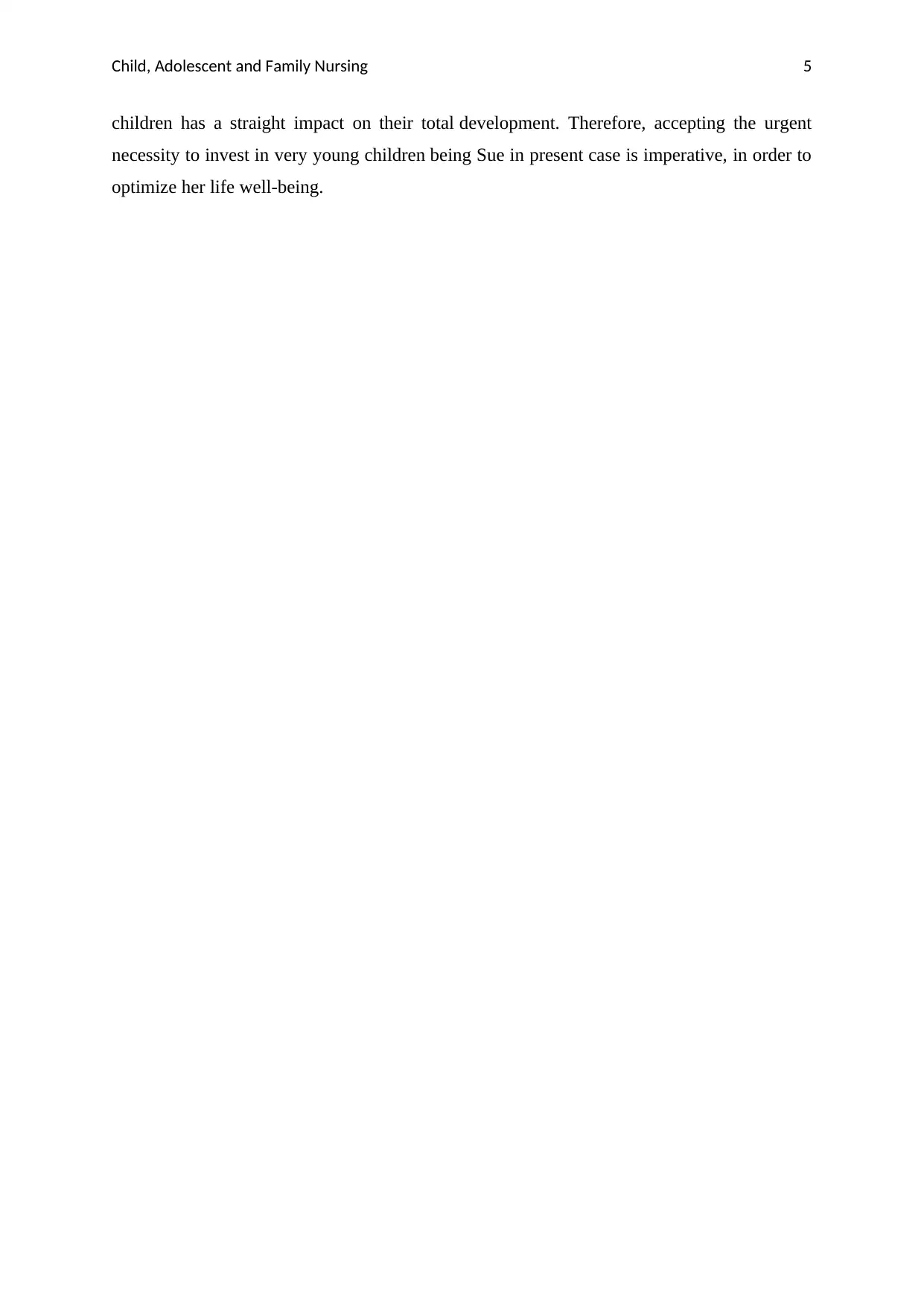
Child, Adolescent and Family Nursing 5
children has a straight impact on their total development. Therefore, accepting the urgent
necessity to invest in very young children being Sue in present case is imperative, in order to
optimize her life well-being.
children has a straight impact on their total development. Therefore, accepting the urgent
necessity to invest in very young children being Sue in present case is imperative, in order to
optimize her life well-being.
⊘ This is a preview!⊘
Do you want full access?
Subscribe today to unlock all pages.

Trusted by 1+ million students worldwide
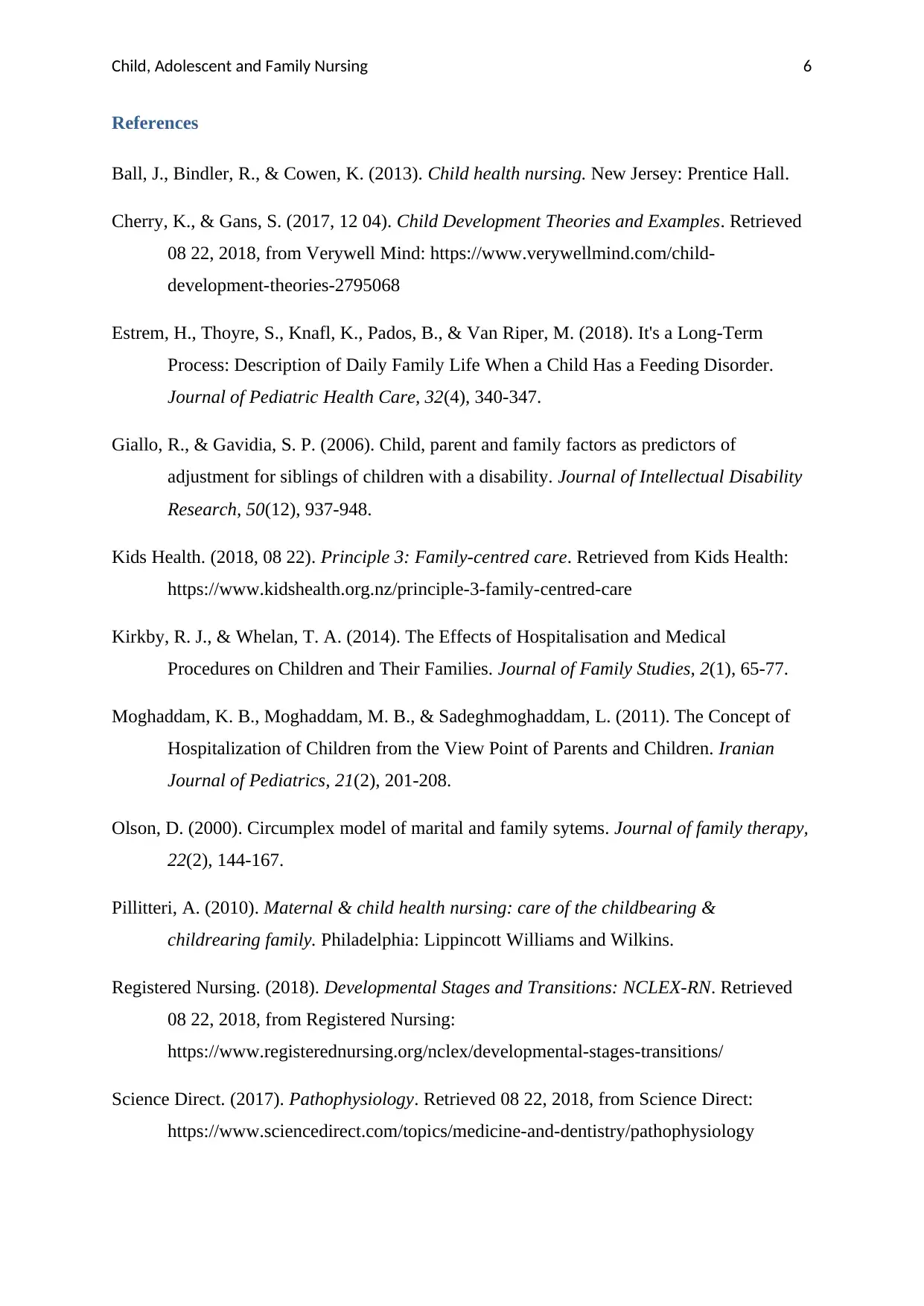
Child, Adolescent and Family Nursing 6
References
Ball, J., Bindler, R., & Cowen, K. (2013). Child health nursing. New Jersey: Prentice Hall.
Cherry, K., & Gans, S. (2017, 12 04). Child Development Theories and Examples. Retrieved
08 22, 2018, from Verywell Mind: https://www.verywellmind.com/child-
development-theories-2795068
Estrem, H., Thoyre, S., Knafl, K., Pados, B., & Van Riper, M. (2018). It's a Long-Term
Process: Description of Daily Family Life When a Child Has a Feeding Disorder.
Journal of Pediatric Health Care, 32(4), 340-347.
Giallo, R., & Gavidia, S. P. (2006). Child, parent and family factors as predictors of
adjustment for siblings of children with a disability. Journal of Intellectual Disability
Research, 50(12), 937-948.
Kids Health. (2018, 08 22). Principle 3: Family-centred care. Retrieved from Kids Health:
https://www.kidshealth.org.nz/principle-3-family-centred-care
Kirkby, R. J., & Whelan, T. A. (2014). The Effects of Hospitalisation and Medical
Procedures on Children and Their Families. Journal of Family Studies, 2(1), 65-77.
Moghaddam, K. B., Moghaddam, M. B., & Sadeghmoghaddam, L. (2011). The Concept of
Hospitalization of Children from the View Point of Parents and Children. Iranian
Journal of Pediatrics, 21(2), 201-208.
Olson, D. (2000). Circumplex model of marital and family sytems. Journal of family therapy,
22(2), 144-167.
Pillitteri, A. (2010). Maternal & child health nursing: care of the childbearing &
childrearing family. Philadelphia: Lippincott Williams and Wilkins.
Registered Nursing. (2018). Developmental Stages and Transitions: NCLEX-RN. Retrieved
08 22, 2018, from Registered Nursing:
https://www.registerednursing.org/nclex/developmental-stages-transitions/
Science Direct. (2017). Pathophysiology. Retrieved 08 22, 2018, from Science Direct:
https://www.sciencedirect.com/topics/medicine-and-dentistry/pathophysiology
References
Ball, J., Bindler, R., & Cowen, K. (2013). Child health nursing. New Jersey: Prentice Hall.
Cherry, K., & Gans, S. (2017, 12 04). Child Development Theories and Examples. Retrieved
08 22, 2018, from Verywell Mind: https://www.verywellmind.com/child-
development-theories-2795068
Estrem, H., Thoyre, S., Knafl, K., Pados, B., & Van Riper, M. (2018). It's a Long-Term
Process: Description of Daily Family Life When a Child Has a Feeding Disorder.
Journal of Pediatric Health Care, 32(4), 340-347.
Giallo, R., & Gavidia, S. P. (2006). Child, parent and family factors as predictors of
adjustment for siblings of children with a disability. Journal of Intellectual Disability
Research, 50(12), 937-948.
Kids Health. (2018, 08 22). Principle 3: Family-centred care. Retrieved from Kids Health:
https://www.kidshealth.org.nz/principle-3-family-centred-care
Kirkby, R. J., & Whelan, T. A. (2014). The Effects of Hospitalisation and Medical
Procedures on Children and Their Families. Journal of Family Studies, 2(1), 65-77.
Moghaddam, K. B., Moghaddam, M. B., & Sadeghmoghaddam, L. (2011). The Concept of
Hospitalization of Children from the View Point of Parents and Children. Iranian
Journal of Pediatrics, 21(2), 201-208.
Olson, D. (2000). Circumplex model of marital and family sytems. Journal of family therapy,
22(2), 144-167.
Pillitteri, A. (2010). Maternal & child health nursing: care of the childbearing &
childrearing family. Philadelphia: Lippincott Williams and Wilkins.
Registered Nursing. (2018). Developmental Stages and Transitions: NCLEX-RN. Retrieved
08 22, 2018, from Registered Nursing:
https://www.registerednursing.org/nclex/developmental-stages-transitions/
Science Direct. (2017). Pathophysiology. Retrieved 08 22, 2018, from Science Direct:
https://www.sciencedirect.com/topics/medicine-and-dentistry/pathophysiology
Paraphrase This Document
Need a fresh take? Get an instant paraphrase of this document with our AI Paraphraser
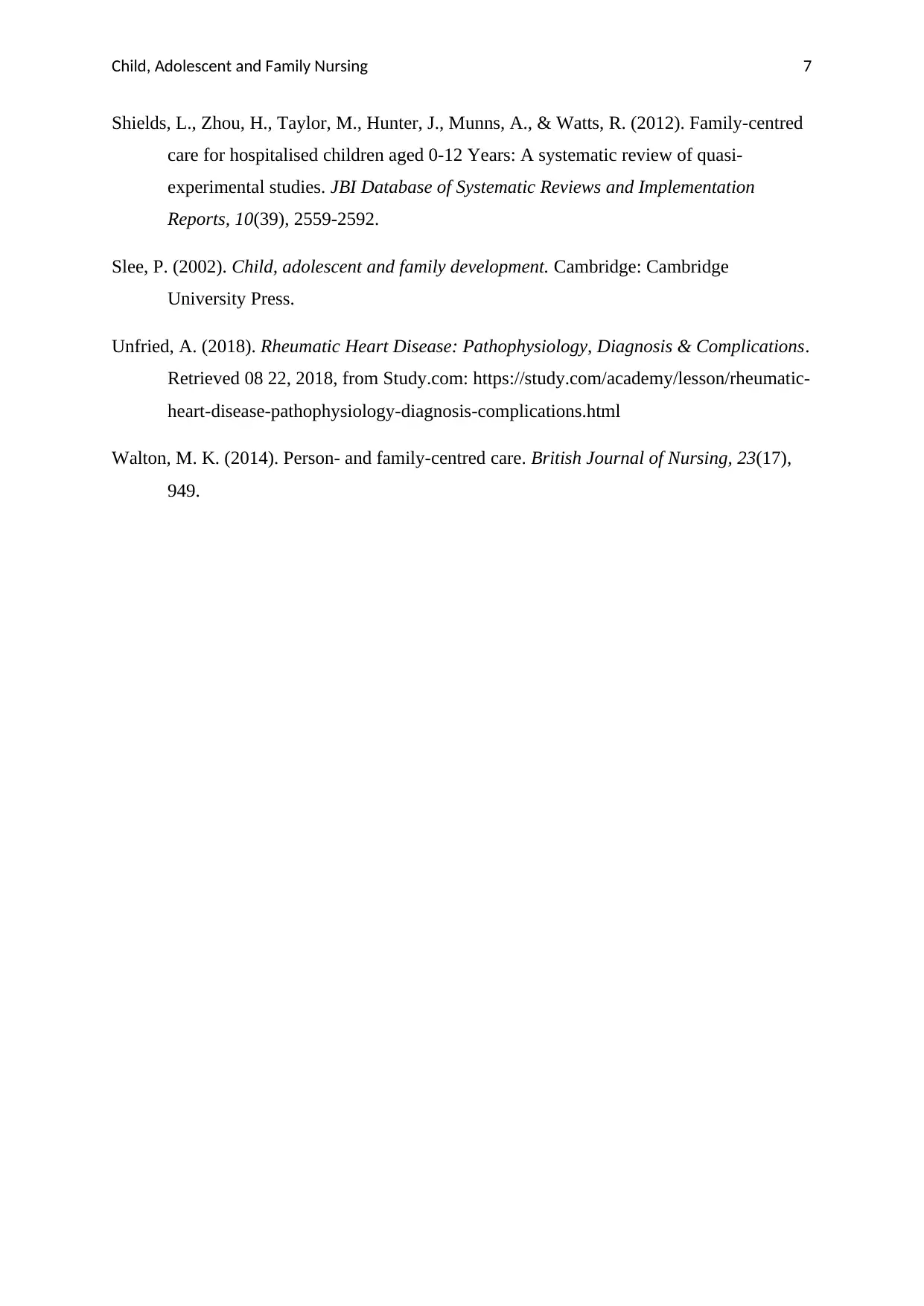
Child, Adolescent and Family Nursing 7
Shields, L., Zhou, H., Taylor, M., Hunter, J., Munns, A., & Watts, R. (2012). Family-centred
care for hospitalised children aged 0-12 Years: A systematic review of quasi-
experimental studies. JBI Database of Systematic Reviews and Implementation
Reports, 10(39), 2559-2592.
Slee, P. (2002). Child, adolescent and family development. Cambridge: Cambridge
University Press.
Unfried, A. (2018). Rheumatic Heart Disease: Pathophysiology, Diagnosis & Complications.
Retrieved 08 22, 2018, from Study.com: https://study.com/academy/lesson/rheumatic-
heart-disease-pathophysiology-diagnosis-complications.html
Walton, M. K. (2014). Person- and family-centred care. British Journal of Nursing, 23(17),
949.
Shields, L., Zhou, H., Taylor, M., Hunter, J., Munns, A., & Watts, R. (2012). Family-centred
care for hospitalised children aged 0-12 Years: A systematic review of quasi-
experimental studies. JBI Database of Systematic Reviews and Implementation
Reports, 10(39), 2559-2592.
Slee, P. (2002). Child, adolescent and family development. Cambridge: Cambridge
University Press.
Unfried, A. (2018). Rheumatic Heart Disease: Pathophysiology, Diagnosis & Complications.
Retrieved 08 22, 2018, from Study.com: https://study.com/academy/lesson/rheumatic-
heart-disease-pathophysiology-diagnosis-complications.html
Walton, M. K. (2014). Person- and family-centred care. British Journal of Nursing, 23(17),
949.
1 out of 8
Your All-in-One AI-Powered Toolkit for Academic Success.
+13062052269
info@desklib.com
Available 24*7 on WhatsApp / Email
![[object Object]](/_next/static/media/star-bottom.7253800d.svg)
Unlock your academic potential
Copyright © 2020–2026 A2Z Services. All Rights Reserved. Developed and managed by ZUCOL.


